As a prepper, I am constantly looking for food sources in the wild. We regularly go foraging for greens, berries, and mushrooms. However, I am also looking for some of those outside the box foods that I can preserve and keep on hand all year.
Pine pollen is one of those foods. While it has medicinal qualities, I really collect it because of the flavor it adds so some of the dishes I cook. Be aware that it is very possible to be allergic to pine pollen, so you might try just a little before you spend hours harvesting it.
In this article I will cover how to collect pine pollen, how to store it, and how to cook with it.
Related: How to Make Pine Syrup at Home (Step by Step Guide With Pictures)
Harvesting
If you have lots of pine trees in your area, you may notice a light coating of pollen on your car in May or June. The tricky part of harvesting pine pollen is collecting it before the wind blows it all away. The window for collecting it will vary based on where you live and the temperatures that year, but May is typically a good time to check.
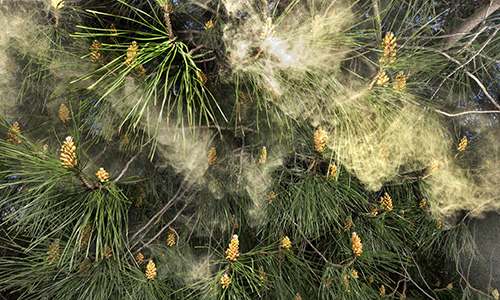 Head to an area of the forest with lots of pine trees. Red pines seem to work best for this. To determine if it is time to harvest, you will want to see lots of male catkins. They will be yellow and fat with lots of pollen when you have reached the harvesting window.
Head to an area of the forest with lots of pine trees. Red pines seem to work best for this. To determine if it is time to harvest, you will want to see lots of male catkins. They will be yellow and fat with lots of pollen when you have reached the harvesting window.
The catkins must have the pollen sifted out of them. The best way to do this is to dry them first. Bring a paper bag and a pair of scissors with you. Carefully cut the catkins from the tree but try to limit yourself to removing 1/3 of them on any given tree. This will ensure that the tree remains healthy. You will want at least one full bag for a decent haul. Head home and find a cool, dry place to dry out the catkins if you want to do it the old fashioned way.
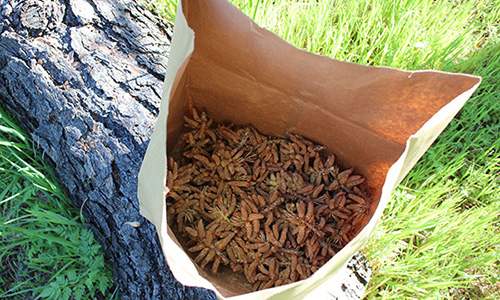 Spread out paper to catch the pollen that falls off and spread out the catkins. Give it a few days for them to dry out. If they are damp, this will not work. You will just end up with mold. The more modern way to dry them out is to use a dehydrator. Place them all on a tray for at least a few hours but leave them to dry overnight if they were damp.
Spread out paper to catch the pollen that falls off and spread out the catkins. Give it a few days for them to dry out. If they are damp, this will not work. You will just end up with mold. The more modern way to dry them out is to use a dehydrator. Place them all on a tray for at least a few hours but leave them to dry overnight if they were damp.
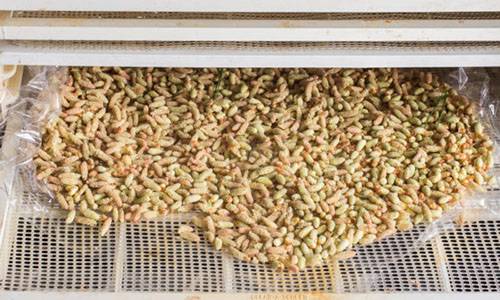 Once they are dry, just put them in a strainer and shake the pollen onto a tray to collect it. Be sure not to crush the catkins. You might think it would be faster to use a food processor, but that will leave catkin fibers mixed in with the pollen. You want pure pine pollen. Once you have shaken all of the pollen loose, sift it through the strainer again just to be sure you got rid of any fibers or other debris.
Once they are dry, just put them in a strainer and shake the pollen onto a tray to collect it. Be sure not to crush the catkins. You might think it would be faster to use a food processor, but that will leave catkin fibers mixed in with the pollen. You want pure pine pollen. Once you have shaken all of the pollen loose, sift it through the strainer again just to be sure you got rid of any fibers or other debris.
Storage
This part of the process is the most important. If you don’t store your pine pollen correctly, it will lose its unique flavor.
Your best options are to keep it refrigerated or frozen depending on how long you plan to store it. Double vacuum seal the pollen if you can to keep air out of the package. Do not put it in a plastic container as they are porous, and you tend to get freezer burn. You might be able to get away with freezing it in a glass jar if you get a good seal.
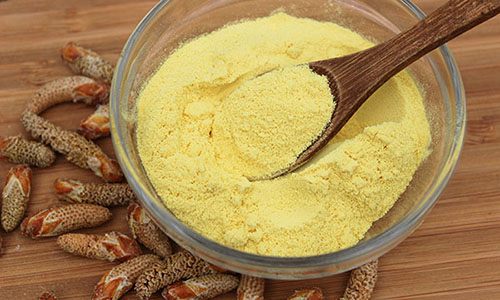 In my experience you can leave pine pollen in the refrigerator for about a week. However, if the air is removed you can keep it in the freezer for about a year.
In my experience you can leave pine pollen in the refrigerator for about a week. However, if the air is removed you can keep it in the freezer for about a year.
Related: How Long Can You Store Food In The Freezer? (Infographic)
Cooking with Pine Pollen
I typically use pine pollen in small amounts as seasoning for dishes. Pine pollen contains testosterone, so I try not to go overboard with it. Typically, I will cook it with stock, salt, and some fat.
Raw pine pollen does not have much of a flavor to it. However, once you add fat and salt it gets an almost cheese like flavor. I like to cook it with mushrooms and greens for a truly local dish. Here are a couple recipes you can try out to get you started.
Pasta in Pine Pollen Sauce
This recipe is very simple and can be modified however you like. If you prefer, you can add meatballs, ground beef, or ground sausage. Put the pasta of your preference in a pot of boiling water. In another pot heat up your favorite marinara sauce or make your own. You can make marinara just by cooking down tomatoes, tomato sauce, tomato paste, garlic, basil, oregano, salt, and pepper. You can add veggies like onions or celery if you like. Once your sauce is hot, add either butter or bacon fat. Then add salt, pepper, and pine pollen.
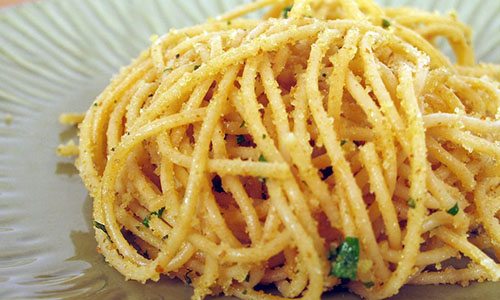 Let it cook for a few minutes and taste. It should have a nice cheesy flavor. If not, add some more and cook for a few more minutes. When the pasta is cooked to your liking, strain it and add it to the pot of sauce. The pasta will absorb the sauce in just a minute or two. Now you are ready to serve.
Let it cook for a few minutes and taste. It should have a nice cheesy flavor. If not, add some more and cook for a few more minutes. When the pasta is cooked to your liking, strain it and add it to the pot of sauce. The pasta will absorb the sauce in just a minute or two. Now you are ready to serve.
Creamy Pine Pollen Chicken Thighs
Start by browning all of the chicken thighs in a pan with oil or in the oven at 350F. It does not have to be cooked all the way through as it will continue to cook in the sauce. Get a large skillet on medium heat and add butter or bacon fat. Then add a little flour and whisk to create a roux. You want it to be just past blond for this recipe. Add in onions and garlic and cook until they are translucent. Now add a good amount of heavy cream and salt and pepper to taste. Add a can of stewed tomatoes and a bunch of fresh spinach.
Once the spinach is wilted and the sauce is a nice pink color, add in the chicken thighs. Now sprinkle the pine pollen over the top, cover, and let simmer for 30 minutes. Serve by itself or over rice or pasta.

Related: Meal in a Bag: Hamburger Gravy and Mashed Potatoes
As you can see, pine pollen is relatively easy to collect. It is also simple to store it and add it to your favorite dishes throughout the year. Do not limit yourselves to these two recipes. Any dish that could use a bit of a cheesy kick can use some pine pollen.
The trick is to hit the pine groves at the right window. I usually check about once a week until I know the pines are ready for harvest. If you do the same, you should have a big haul and be good until the following year.
You may also like:
How to Make a Year-Round Self-Sustaining Greenhouse No Matter Where you Live in America (Video)
5 Devious Strategies That Will Get Preppers Killed

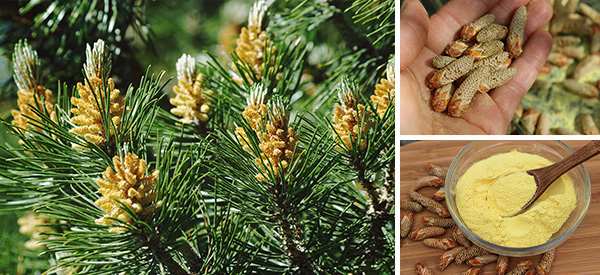
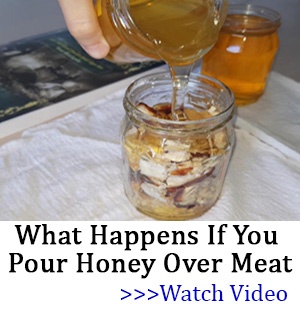













In my area of the Northwest, we do not have many pines we have in abundance Douglas fir. Is it possible to obtain/use those for pollen collection?
Curious: I thought you never ran away farther than the farm? 🙂 Yep, grandkids, and have the scars to prove it! What you were asking.
https://honest-food.net/edible-pine-tree-nuts-pollen-tips/#:~:text=Yes%2C%20you%20can%20eat%20pine,turpentine%20and%20more%20like%20citrus.
Red: You come up with the best references. The url you posted above answered may question about the bull pine in the PDRK, no it is not the loblolly pine. It is much better as far as pine nuts are concerned. Great reference. Thanks for posting it.
LCC: You encourage all of us to do better if only to avoid that boot 🙂 niio
Off topic but perhaps of interest:
“ELECTION DAY SUNSPOT: One of the biggest sunspots in years is emerging on the sun today. Hours ago it produced a C-class solar flare and a minor radio blackout over the Indian Ocean. This sunspot, if it holds itself together, will face Earth for the next two weeks as it rotates across the face of the sun, potentially setting the stage for a sustained stretch of solar activity. Visit Spaceweather.com for updates.”
Wow, I live in pine tree heaven and have never heard of anything like this before. Pine pollen gets so thick here, on our cars (in SC) and solar panels that it has to be washed off daily. Bump a pine tree during the season and you’re covered in yellow. We can collect ours with tarps I suspect. Now I gotta try this!
I’ve always wondered how useful the Southeastern pines are because they have more turpentine than other pines around the country. Here’s a good link about a common Southern pine, Loblolly, all kinds of stuff I didn’t know about Loblolly.
https://eatwild.weebly.com/blog/plentiful-pines
Interesting article, Mike. Thanks for posting the url.
The author said another name for the loblolly is bull pine.
I was looking at some rural property a while back and mentioned the pine trees growing on the land and the man showing the land said they were bull pines. I must admit that my expertise in pine trees is that I can tell an evergreen tree from a sycamore. As to whether the evergreen is a pine tree or a hemlock (they are different, aren’t they?) I will take your word for whatever you say they are. Now whether the trees he identified as bull pines are the same as the loblolly pines growing in Alabama your guess is probably better than mine. If they are the same, then it would appear the range of the tree exceeds what the article mentioned and extends all the way to northern SoCal. The line between NorCal and SoCal is kind of vague, so the property could just as well be described as southern NorCal.Yeah, I agree, the folks in the PDRK are confused about a lot of things.
OK, got try this in the spring. ! niio
This is fabulous – I’ve never heard of consuming pine pollen. I’m allergic to some pine pollen but I don’t know which type, nor do I know if eating it is different. If I get a chance, I’ll absolutely try it out. Thank you for sharing this.
Christopher Nyrges, a naturalist here in SoCal eats young poison oak leaves in the springtime to give him immunity from the mature plant later in the year. He claims that it was a practice of the Chumash before the Spaniards got here. Not totally sure of the spelling of his last name but it should be close enough to get to his website if you want further info.
That’s a little too much of a risk for me. I think I am immune to poison ivy/oak due to a massive dose I had when quite young. However, I do not put that theory to the test and avoid patches of both plants.
My father was immune to the plants and used to pull the plants out with his bare hands. He never ate young leaves but just came by his immunity naturally.
It seems to me if you ingest the pollen, one of two things will happen. You will develop an immunity to pine pollen or you will have the worst case of spring fever with severe response to the irritant. I would start out with small doses at first were I to undertake an immunization. That’s what doctors do when they try to immunize you against allergens, inject you with weak dosages of it increasing as you develop the immunity.
Thanks Chuck for your comment.
I have a theory but may be completely wrong…when I was a youngster back in the 1950s mom hung out our washed clothes on the clothes line in the fresh air with all the pollen from every plant around our house. I played in the woods and I never got poison ivy or poison oak.
Then clothes dryers came along. Clothes were not hung on the clothes line much anymore. I got my first case of poison ivy when I was about 20 years old. We had a clothes dryer so my wife didn’t hang our clothes outside on the clothes line.
I believe my immunities changed because I wasn’t exposed to the pollen in the air as much as before.
Mailpouch: I believe there may be some validity to your observations. I have read that Amish and Mennonite children are not nearly as subject to allergies as non-members of their religion. Folks who claim to have studied the difference believe it is because those children continue to live much as children did 100 years ago. There is absolutely no question that allergies are more common today than they were 100 years ago.
Other posters on this list have indicated as I have that when I was a kid peanut butter was a staple of every kid’s diet. None of the kids I associated with had peanut allergy. Everyone’s favorite sandwich was peanut butter and jelly. Peanut butter was included in C-rations and was one of the treasured items in a day’s C-rations. It was a lucky day if you got peanut butter. The current hysteria over peanuts is beyond belief for me.
I still hang clothes on a line outdoors. It cuts my electric bill in half as opposed to using the electric clothes dryer. That does two things. One, it gets me in practice for the day when the electricity dies. Secondly, it gives me extra money each month to use for prepping. Hanging clothes on a clothes line may seem like simple work but there are techniques involved that make the job easier.
A favorite saying of mine is “Brain surgery looks easy when you know what you are doing.” That aphorism holds true for any occupation no matter how simple it may look.
When my daughter was in Bluebirds many years ago all the mothers in her group were amazed that she could easily use scissors. My wife who was native Japanese was amazed that their daughters didn’t know how to use scissors. Every Japanese child learns how to use scissors by the time they are old enough to hold the scissors in their hands.
I recently read a post by a father who had gotten his son a cub scout pocket knife for a badge that he wanted. He was worried about his son not being able to open the blade because it was stiff. He was also worried about his son not being careful enough when closing the knife. He felt it was too dangerous for a boy of cub scout age to use such a dangerous instrument.
Jeez Louise! Leave the kid alone. He will soon discover that a dime will work as a device to operate the blade. The edge of the dime will fit in the nail pick. He will very quickly learn a method to close the blade without ensnaring his fingers. He may get cut once or twice but they will be minor cuts and it will be a teaching lesson about blades and injuries from blades. He will be the more skillful boy rather than if he is “saved” from all possible injuries by a helicopter father.
Well, enough of a rant on modern day parenting for this post.
I have a number of pines in my yard and shall have to try this.
mbl: always name names. What kinds of pine? Some are toxic.
https://www.skilledsurvival.com/eating-pine-how-to-eat-a-pine-tree/
The bull pine mentioned in this article is a ponderosa. manga, eat well! niio
Red, I have a few white pines. I also have two other evergreens, one of which is likely spruce. I’ve used some of the white pine needles for tea, but never knew about using pollen.
mbl: Next spring, when the spruce tips come out, try them. Good ones taste like strawberries. White pines are the tree of life among N. East American Indians. I always heard it was a famine food but now need to see how good it is. niio
Thanks, Red, I knew they were edible, but i didn’t know what the tasted like. We have loads of white pine here. The tea is quite tasty, but that’s as far as i’ve gone on the epicurean pine path for now.
Great article from a while back.
https://www.askaprepper.com/recognize-tree-parts-edible/
Another great article from a while back.
https://www.askaprepper.com/cherokees-used-trees-southern-appalachia-food-medicine-craft/
Our farm has radiata pine plantations bordering us on two sides, and a separate property where we lived was also surrounded by pine plantation. Each year pine pollen drifted over everything in springtime.
“Wow,” I thought for one moment when reading the article, “This is something I want to try.” Then it struck me yet again – all the pine plantations on Kangaroo Island, are stark, black, dead trees now. Bushfires back in December-January wiped out everything, including our farm, and the house where we used to live. It takes some getting used to.
I have been researching pine needle tea as the suramin content is a good antidote for The Jab and as a preventative for getting sick in the first place. The needles have the same component as Tamiflu. I did research of tea and not the pollen.
The following trees are either toxic or harmful for pregnant mothers: English Yew (Taxus), Norfolk Island Pine (Araucana heterophylla), Yew Pine ((Podocarpus macrophylla), Ponderosa Pine (Pinus ponderosa), Balsam Fir, Lodgepole Pine (Minus contorta), Monterey Pine, Cypress, Norway Pine, Loblolly Pine, Jeffrey Pine, Eastern White Cedar. Generally avoid flat needles.
The trees that are the best to consume are: White Pine (Pinus strobus), Lodgepole Pine, Balsam Fir, Spruce, Cedar, Red Pine, Masson Pine, Western Larch, Western Red Cedar, Grand Fir, Douglas Fir, Western and Eastern Hemlock (Tsuga pinaceae), of course this is not the same as the poisonous hemlock (Apiaceae) plants by streams and in fields.
I looked for trees in my area of northern mountain states in the U.S.